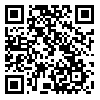Volume 13, Issue 3 (May-June 2014)
Payesh 2014, 13(3): 339-346 |
Back to browse issues page
1- Department of Nursing and Midwifery, Tehran University of Medical Sciences, Tehran, Iran
2- Deptment of Epidemiology and Statistics, School of Health, TehranUniversity of Medical Sciences, Tehran, Iran
2- Deptment of Epidemiology and Statistics, School of Health, TehranUniversity of Medical Sciences, Tehran, Iran
Abstract: (4419 Views)
Objective (s): Burnout has been described as a syndrome of emotional exhaustion, depersonalization, and decreased personal accomplishment. Measuring burnout among midwives is important because their well-being has implications for stability in the healthcare workforce and for the quality of care provided.
Methods: This was a cross-sectional study. A sample of 300 midwives who were working in teaching hospitals and health centers took part in the study. The data were collected by a designed questionnaire and the Maslach Burnout Inventory. Results: Moderate and severe job burnout were found in most participants (76.7%). There were low levels of emotional exhaustion (59.7%) and depersonalization (75%), and personal accomplishment (59.3%) . There were a significant inverse association between age and depersonalization (p = 0.03), a significant direct association between education and emotional exhaustion (p = 0.04) and between three dimensions of job burnout and place of work (p = 0.02). However, no significant relationships were found between job burnout and marital status and employment status.
Conclusion: Midwives’ level of burnout was found to be relatively substantial. Interventions at individual and organizational levels are needed to respond to job demands, minimize the level of chronic stress and decrease the prevalence of job burnout.
Methods: This was a cross-sectional study. A sample of 300 midwives who were working in teaching hospitals and health centers took part in the study. The data were collected by a designed questionnaire and the Maslach Burnout Inventory. Results: Moderate and severe job burnout were found in most participants (76.7%). There were low levels of emotional exhaustion (59.7%) and depersonalization (75%), and personal accomplishment (59.3%) . There were a significant inverse association between age and depersonalization (p = 0.03), a significant direct association between education and emotional exhaustion (p = 0.04) and between three dimensions of job burnout and place of work (p = 0.02). However, no significant relationships were found between job burnout and marital status and employment status.
Conclusion: Midwives’ level of burnout was found to be relatively substantial. Interventions at individual and organizational levels are needed to respond to job demands, minimize the level of chronic stress and decrease the prevalence of job burnout.
type of study: Descriptive |
Accepted: 2013/10/22 | ePublished ahead of print: 2014/04/28 | Published: 2014/05/15
Accepted: 2013/10/22 | ePublished ahead of print: 2014/04/28 | Published: 2014/05/15
| Rights and Permissions | |
 |
This work is licensed under a Creative Commons Attribution-NonCommercial 4.0 International License. |



